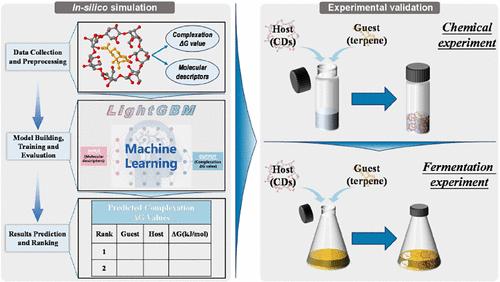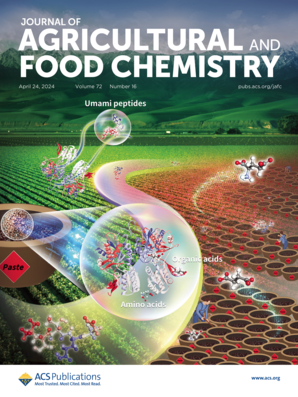Machine Learning-Guided Selection of Cyclodextrins for Enhanced Biosynthesis and Capture of Volatile Terpenes
IF 5.7
1区 农林科学
Q1 AGRICULTURE, MULTIDISCIPLINARY
引用次数: 0
Abstract
Nootkatone and limonene are valuable volatile organic compounds (VOCs), but their biosynthetic production is hindered by volatility. This study employed machine learning to guide cyclodextrin (CD) selection for encapsulating these VOCs, with a focus on nootkatone capture during fermentation to prevent losses and potentially replace dodecane as an organic solvent extractant. A LightGBM model accurately predicted complexation free energies (ΔG) between CDs and guest molecules (R2 = 0.80 on a 10% test set, with a mean absolute error of 1.31 kJ/mol and a root-mean-squared error of 1.90 kJ/mol). Experimental ranking of 7 CD types validated the model’s ΔG predictions and encapsulation performance rankings. Nootkatone showed high encapsulation efficiencies ranging from 21.29% (α-CD) to 88.41% (Me-β-CD), capturing 22.61–116.71 mg/g CD. Notably, Hp-γ-CD, which is the least studied or used CD in research, performed well with nootkatone (63.64%, 84.01 mg/g CD) despite model discrepancies. For limonene, encapsulation efficiencies spanned from 0.62% (Hp-γ-CD) to 55.45% (β-CD), with 0.61–84.28 mg/g CD encapsulated. Constructed engineered Saccharomyces cerevisiae strains produced nootkatone (up to 97.30 mg/L captured by 10 mM Me-β-CD) from de novo fermentation using glucose as a carbon source. This approach demonstrated the potential of CDs to replace dodecane as an organic solvent for terpene extraction during fermentation. The study highlights machine learning’s potential for guiding CD selection to enhance volatile terpene biosynthesis, capture, and utilization during fermentation, offering a more environmentally friendly alternative to traditional organic solvent-based extraction methods.

求助全文
约1分钟内获得全文
求助全文
来源期刊
CiteScore
9.90
自引率
8.20%
发文量
1375
审稿时长
2.3 months
期刊介绍:
The Journal of Agricultural and Food Chemistry publishes high-quality, cutting edge original research representing complete studies and research advances dealing with the chemistry and biochemistry of agriculture and food. The Journal also encourages papers with chemistry and/or biochemistry as a major component combined with biological/sensory/nutritional/toxicological evaluation related to agriculture and/or food.

 求助内容:
求助内容: 应助结果提醒方式:
应助结果提醒方式:


